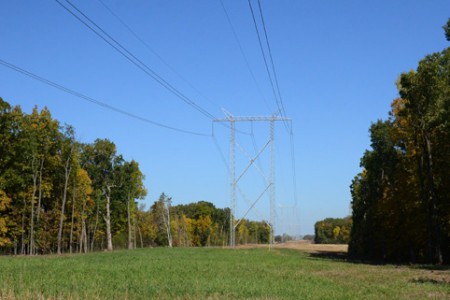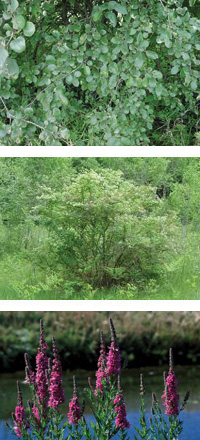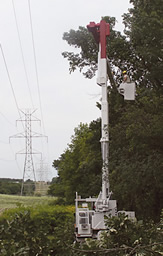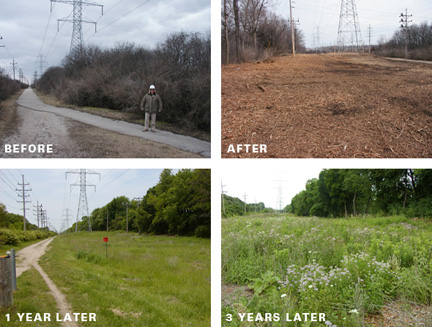Vegetation management
ATC works to balance its obligation to operate its facilities safely and reliably with its commitment to being a respectful neighbor. For safety and reliability reasons, trees and other vegetation are controlled and managed around high-voltage power lines and facilities. While tree removals are not a popular activity, ATC has a duty and responsibility as a public utility to ensure safe and reliable electric service to the homes and businesses that count on it every day.
Trees can compromise safety by arcing or sparking which can lead to fire or electrocution. Trees also can cause interruptions in electric service if adequate clearances are not maintained and/or they grow into or fall on the lines. ATC identifies and addresses vegetation concerns to provide the highest level of reliability and to keep your family safe.
Watch a brief video about our vegetation management program.
The utility corridor is maintained for safety and reliability
ATC conducts utility corridor vegetation management approximately every five years with the goal of removing all incompatible vegetation from the easement. Interim work to trim or remove vegetation is sometimes needed as a result of periodic inspections. A high-voltage power line utility corridor typically includes land directly beneath the wires (wire zone) and land between the wire zone and the edge of the corridor (border zone). In all cases, incompatible vegetation within the wire zone will be cleared regardless of height. Tall-growing trees and vegetation, brush and invasive species will also be cleared from the border zone, but some small, low-growing shrubs and plants may be permitted. While many property owners will use the easement area for gardens, prairie plantings, wild flowers, along with other non-vegetation uses, anything planted in the easement is at risk for removal should conditions or circumstances relating to the operation or maintenance of our facilities warrant it.
ATC forestry crews use manual, mechanical and herbicide control methods to achieve a clear and safe utility corridor. Beyond the edges of the corridor, large trees that are dead, dying, diseased or leaning that pose a threat to high-voltage power lines and structures are removed or pruned.
Incompatible species are removed
The dense growth of incompatible plants can impede access to our equipment. By clearing this kind of vegetation, we are better able to inspect and maintain our facilities and expose fast-growing trees that may be hidden from sight. This practice is consistent with the Wisconsin Department of Natural Resources initiative to control and eliminate invasive plants.
Invasive plants found along our utility corridor are predominantly a combination of buckthorn and exotic honeysuckles. They are considered invasive because they have longer growing seasons and drain soil nutrients and water, which enables them to choke out native plants. Removing them from high-voltage power line corridors allows low-growing native vegetation in the area to quickly re-establish and improves biodiversity.
Forestry crews are professionals
ATC contracts with professional tree trimming and removal companies that have extensive experience in proper pruning and removal techniques. These crews participate in required training sessions on a variety of work-related topics and field issues. They carry identification showing their affiliation with ATC.
Rights-of-way and power lines are inspected
ATC’s vegetation maintenance cycle is typically five years. However, all of our facilities are inspected on an annual basis either on foot or by helicopter to identify any necessary repairs, deterioration or vegetation threats to our facilities that must be addressed prior to the next scheduled maintenance cycle.
Maintenance work is discussed with landowners
We know property owners near our facilities will have questions about vegetation management and it is our goal to provide opportunities to discuss our plans before our forestry contractors arrive for scheduled work. Typically we notify landowners by mail in advance and provide a description of our plans, the reason for the work, time frame and contact information for a designated ATC representative. We aim to provide ample time for the property owner to identify and make arrangements to relocate trees or bushes if they can be moved safely.
Herbicide use
Vegetation that is likely to re-sprout after cutting may be treated with herbicides to inhibit re-growth. Years of experience and study by the utility industry have demonstrated that one of the most efficient and effective ways to keep utility corridors clear of unwanted trees and brush is through the careful and selective use of herbicides. Herbicides are often used following clearing and mowing to control re-growth of unwanted, incompatible vegetation, and will not affect grasses and other non-woody species. In many cases, the vegetation removed from dense areas is not desirable native vegetation, but invasive plants like buckthorn and honeysuckle. These fast-growing plants not only hinder crew access to the utility facilities, but choke out and compete with native grasses and plants for nutrients, sunlight and water. Eliminating incompatible vegetation in the corridor promotes the growth of native grasses, low-growing shrubs and other native ground cover that birds, deer and small animals prefer.
Low-growing vegetation is compatible with power lines
Grow low and keep the power flowing. Many property owners plant gardens, flowers, grasses and low-growing vegetation within the borde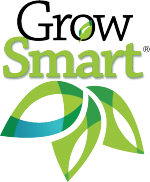 r zone area of the easement. This type of vegetation may not pose problems for the property owner or our facilities. Under the terms of the easement however, any and all vegetation (as well as structures, sheds, etc.) located within the utility corridor is at risk of removal should circumstances warrant it. Keep in mind that small, immature trees planted today can grow into problem trees in the future. Check out our Grow Smart page to learn about low-growing, beautiful vegetation that can be planted within high-voltage power line corridors.
r zone area of the easement. This type of vegetation may not pose problems for the property owner or our facilities. Under the terms of the easement however, any and all vegetation (as well as structures, sheds, etc.) located within the utility corridor is at risk of removal should circumstances warrant it. Keep in mind that small, immature trees planted today can grow into problem trees in the future. Check out our Grow Smart page to learn about low-growing, beautiful vegetation that can be planted within high-voltage power line corridors.
While still subject to removal under the terms of the easement, these suggested species of grasses and flowers are less likely to interfere with access for emergency or maintenance crews than shrubs or tall-growing vegetation.
Trees are permitted outside of the utility corridor, as long as they do not encroach on the corridor area. Several studies have shown that planting the right tree in the right place can provide energy-saving benefits by cutting energy used by heating and air conditioning units. The shade provided by trees reduces air temperature, decreases the amount of radiant energy absorbed and stored by buildings and paved surfaces and also cut the wind, slowing the infiltration of outside air into climate-controlled structures. To learn about conserving energy for your home by planting the right tree in the right place, please visit the climate change section on the Arbor Day Foundation website.
Natural areas re-establish themselves
The following is a series of photos showing the appearance of a high-voltage power line corridor before and after dense, invasive vegetation is cleared from the utility corridor.
Tree Line USA®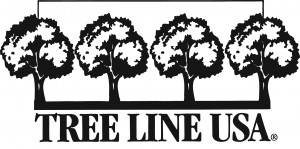
Every day in communities all across America, people depend on safe, reliable electric service to power their homes, businesses, and public buildings. The TreeLine USA® program administered by the Arbor Day Foundation exists to recognize best practices in public and private utility arboriculture to utilities that demonstrate how trees and utilities can co-exist for the benefit of communities and citizens.
ATC has received the TreeLine USA® designation every year since 2008.

